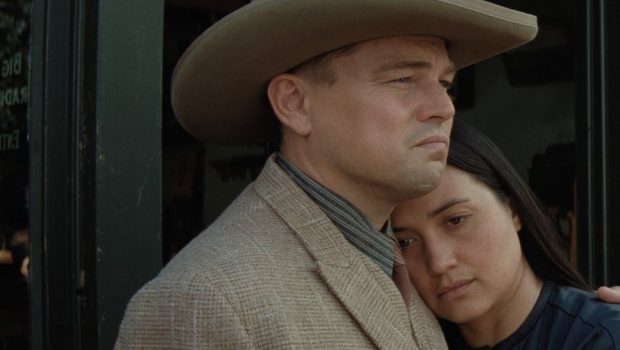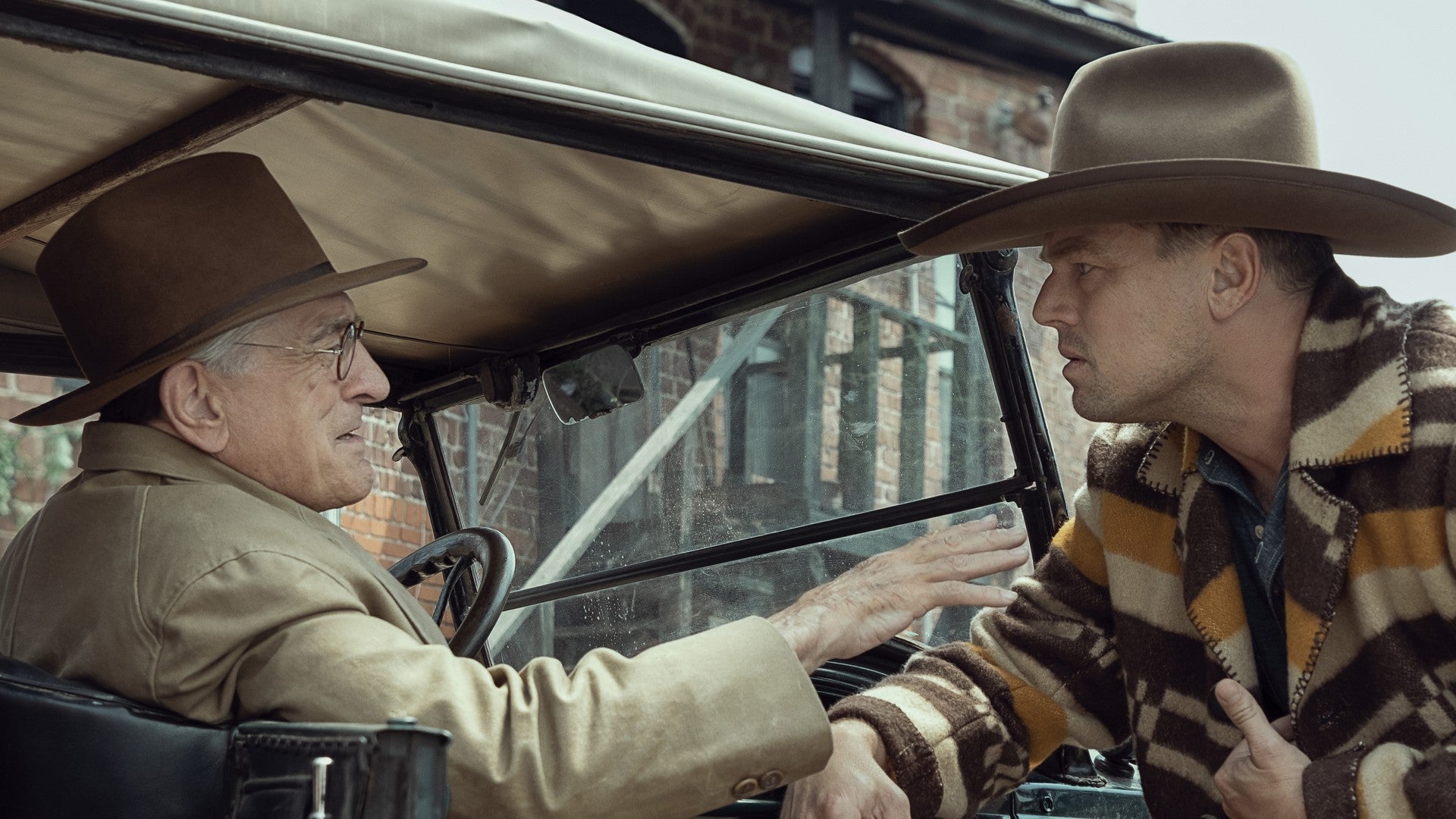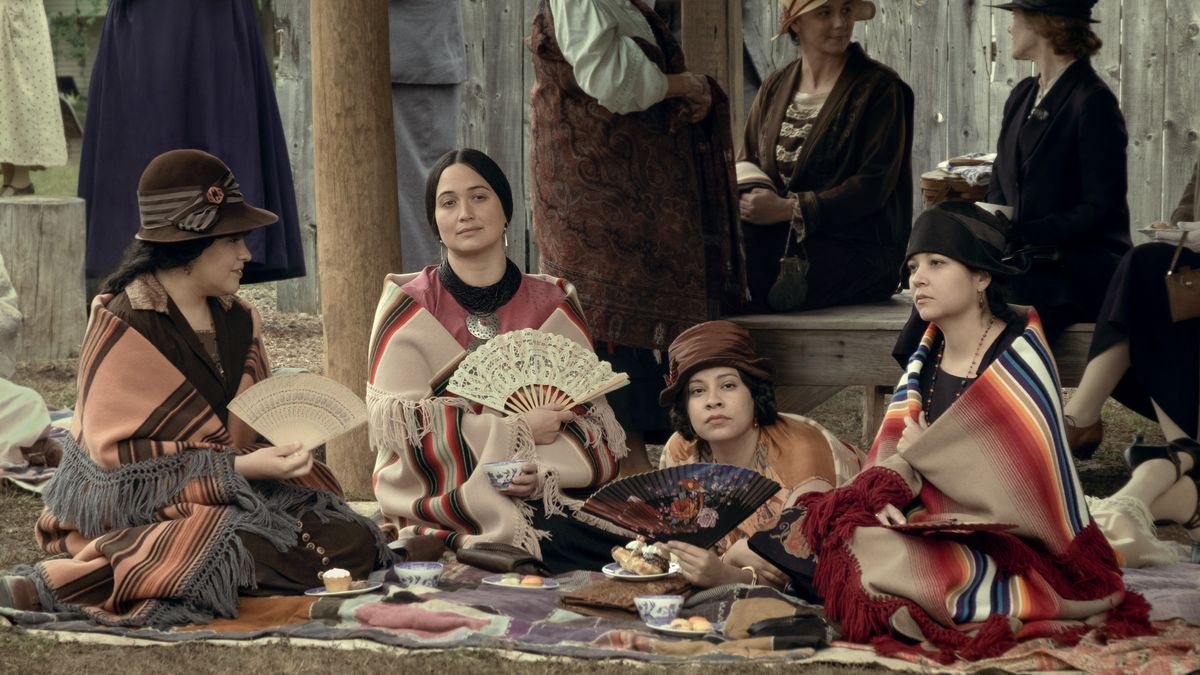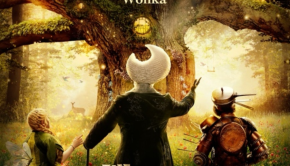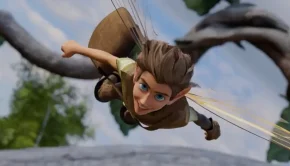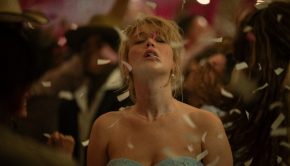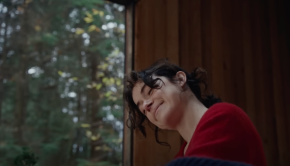Killers of the Flower Moon – Film Review
Reviewed by Damien Straker on the 5th of November 2023
Paramount Pictures presents a film by Martin Scorsese
Screenplay by Eric Roth and Martin Scorsese based on ‘Killers of the Flower Moon’ by David Grann
Produced by Dan Friedkin, Bradley Thomas, Martin Scorsese, and Daniel Lupi
Starring Leonardo DiCaprio, Lily Gladstone, Robert De Niro, Scott Shepherd, Tantoo Cardinal, and Cara Jade Myers
Cinematography Rodrigo Prieto
Edited by Thelma Schoonmaker
Music by Robbie Robertson
Rating: M
Running Time: 206 minutes
Release Date: the 19th of October 2023
For much of its enormous running time, Martin Scorsese’s Killers of the Flower Moon is a highly compelling and mature study of greed and white supremacy. The film stays with us for several reasons. It is one of the few films to look at Native American culture through a highly unique lens. Meanwhile, it is like many of the director’s films unflinching in showing humanity at its absolute worst. Furthermore, Killers is also impeccably crafted and guided by actors at the height of their powers. Lily Gladstone, Leonardo DiCaprio, and Robert De Niro give mesmerising performances that enrich the film over its extensive duration. It takes a steady, unwavering hand to effectively unify both the rich talent and the confronting, topical subject matter. As a result, Scorsese’s film is unnerving and unforgettable.
Scorsese and Eric Roth, credited as the film’s screenwriters, have adapted journalist David Grann’s 2017 non-fiction book of the same name. The story takes place in the 1920s in Oklahoma. Ernest Burkhart (DiCaprio) returns from the First World War where he was a cook. He opts to stay with his brother (Scott Shepherd) and his uncle, William King Hale (De Niro), who is a respected figure in the community. Hale warns him to stay out of trouble. At the same time, he also encourages Ernest to court Mollie (Gladstone). Mollie is a Native American woman who belongs to the Osage Nation. The Osage tribe is enormously wealthy because their people discovered oil in the ground. Hale’s plan is to gradually have the members of Mollie’s family killed so he and Ernest can inherit (steal) the wealth for themselves. The violent escalation takes a punishing toll on Mollie. She also suffers from diabetes and is regularly given insulin shots by Ernest, which has its own nefarious consequences.
Beauty and gruelling violence form a devastating combination throughout Killers. Somehow Scorsese utilises every part of the film’s $200 million dollar budget without the presentation overwhelming the story. Instead, the film is staged with crowded street scenes, impeccable costumes, and old-fashioned motorcars that are appropriate to depicting wealthy Indigenous Americans. Both the town scenes and the rural areas benefit from Rodrigo Prieto’s handsome, naturalistic photography. Early on, there is an incredible frame where the camera peers down from a high angle shot. We hover across the lush green landscape, so the depth of the frame underlines the volume of property belonging to the Indians. The image is pivotal for several reasons. The high angle infers Ernest’s social displacement as he struggles to adapt in post-war America where the social dynamics have changed. Rarely have Native Americans in Hollywood films been portrayed as this wealthy and powerful. Too often throughout film history they have been shown as monosyllabic warriors who brandish hunting weapons and live in tents. This has changed recently in television shows and here the representation it is equally transformative.
What is more predictable for a Scorsese film is the intensity of the story’s violent barbarism. There is nothing to suggest the director, who turned eighty this year, has mellowed. Rather, he knows better than ever about when and how to strategically land a story’s devastating blows. There are many tense low-key conversations staged throughout Killers. This muted, understated form is regularly weaponised. The violence following these exchanges is often a quick visceral burst of pain. These are not huge, showy set pieces but small, devastating skirmishes that show the senseless brutality of white supremacy, mostly at the hands of Hale and his goons. In one quick scene, a man puts his arm out a window to shoot a woman through the chest and then leaves the pistol in her hand. Later, grave robbers smash open a coffin at night to steal some jewels right off a corpse. Even a moment where Scorsese keeps a key murder off-screen, the glimpses of the post-mortem review prove disturbing. Mollie’s devastating emotional reactions are our inlet to this story as she channels our dismay.
The performances and depth of character allow for highly compelling viewing. It is true DiCaprio’s showiness makes for a theatrical performance rather than a naturalistic one. However, he is also strong at showing the nervous energy and cowardice of Ernest. His body language is like a small child as he diminishes before his uncle. The power imbalance is underlined in a weird, unnerving scene where Ernest has his backside paddled by Hale. The spatiality of the scene is narrow and distorted. It infers one of the film’s more subtle ideas about displacement. Post-World War I, Ernest is a lost soul. A stomach problem prevents him from undertaking tough labour. He is also a lousy businessman (‘I love money!’ he squeals) and an equally useless criminal. He stages a minor stick ‘em up robbery only to lose his stash soon afterwards in a card game. Hale later berates him for buying a farm that is infected. He is too stupid for crime and too white to understand the culture into which he marries. What’s a local oaf to do? The story’s dramatic questions revolve around the psychological vice in which he finds himself. For most of the film Ernest is incapable of independent thought. Does he love Mollie, and can he break away from his uncle and brother? It is easy to paint the ambiguity about his intentions as a flaw when it is deliberately underlines Ernest’s indecisiveness.
After Certain Women (2016), Lily Gladstone proves once more she can deliver understated, naturalistic performances. There are tough scenes throughout the film where Mollie breaks down upon learning about the tragedy of each family member. Yet there are also quiet scenes where she is physically intense and still as though she too is displaced. She is wedged between her own ailing culture and the courtship of a white man with powerful friends and family. Her sister (Cara Jade Myers) is a violent alcoholic, and her mother (Tantoo Cardinal) is rapidly ageing. It leaves us asking what she accepts as tragic fatalism. Her physical decline is very well depicted as she is left indisposed while taking her insulin shots. Though some of her agency in the story is arguably suppressed in the second half when she is unwell. Just when you think De Niro cannot forge another major screen monster, he gives one of his most chilling performances. Hale is more than a one-dimensional caricature of a violent mob boss or a greedy capitalist. Instead, he continually gaslights people. He works overtime to sow doubt about his involvement. Everyone he encounters (even his own thugs) is a dispensable chess piece on a board of destruction. The only shortcoming is occasionally losing trace of side characters. Ernest’s brother for example feels very removed from him. Though again this might be to show Ernest’s social detachment.
Given the film’s length it is amazing how Scorsese holds our attention for its duration. His craftsmanship in recreating this shocking part of US history is impeccably realised and devastating to behold. He is unflinching in showing the ruthless violence of mobsters and white supremacists towards Native Americans. It is at once specific but timely because of the rise of white supremacy in the US today. Yet it also helps that away from the gruelling violence the three central performances are so affecting. The main characters are engrained in a different type of representation on screen where Native Americans are wealthy and powerful but also continuously undermined. Ernest’s displacement and inability to gravitate to one group is one of the more fascinating ideas driving the story. I would like to revisit the film and further explore its complex ideas. One hopes there might even be a longer cut to unravel its ambiguous threads and relationships. Regardless, the film is haunting and memorable, which considering the budget and talent is its own sizable achievement.
Summary: The film is haunting and memorable, which considering the budget and talent is its own sizable achievement.


